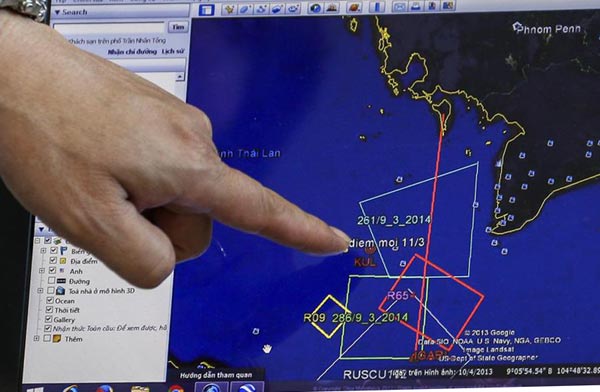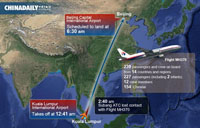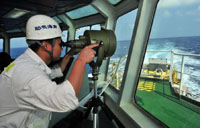|
 |
|
A map of a flight plan is seen on a computer screen during a meeting before a mission to find the Malaysia Airlines flight MH370 that disappeared from radar screens in the early hours of Saturday, at Phu Quoc Airport on Phu Quoc Island March 10, 2014. [Photo/Agencies] |
|
|
 |
 |
KUALA LUMPUR/WASHINGTON - Investigators in Malaysia are voicing skepticism that the airliner that disappeared early Saturday with 239 people on board was the target of an attack, US and European government sources close to the probe said.
The fate of the Malaysian airliner that vanished about an hour into a flight to Beijing remained a mystery, as a massive air and sea search, now in its third day, failed to turn up any trace of the Boeing 777 plane.
Neither Malaysia's Special Branch, the agency leading the investigation locally, nor spy agencies in the United States and Europe have ruled out the possibility that militants may have been involved in downing Malaysia Airlines Flight MH370.
But Malaysian authorities have indicated that the evidence so far does not strongly back an attack as a cause for the aircraft's disappearance, and that mechanical or pilot problems could have led to the apparent crash, the US sources said.
"There is no evidence to suggest an act of terror," said a European security source, who added that there was also "no explanation what's happened to it or where it is."
Meanwhile, dozens of ships and aircraft from 10 countries were still scouring the seas around Malaysia and south of Vietnam as questions mounted over possible security lapses that could have led to a downing of the Boeing 777-200ER after it climbed to an altitude of 35,000 feet (10,670 meters).
Interpol confirmed on Sunday at least two passengers used stolen passports and said it was checking whether others aboard had used false identity documents.
Even so, one US source said Malaysian authorities were leaning away from the theory that the plane was attacked. Their view was mostly based on electronic evidence that indicates the flight may have turned back toward the Malaysian capital of Kuala Lumpur before disappearing.
Even that information has not been clearly confirmed, and investigators and intelligence sources say the fate of the Flight MH370 is still shrouded in mystery.
One reason was that the aircraft had failed to make automatic contact with a flight data-monitoring system after vanishing from radar screens, two people familiar with the matter said on Monday. Such contact could have helped investigators determine what happened.
The aircraft was equipped with a maintenance computer capable of talking to the ground automatically through short messages known as ACARS. "There were no signals from ACARS from the time the aircraft disappeared," a source involved in the investigations said.
Also raising doubts about the possibility of an attack, the United States extensively reviewed imagery taken by spy satellites for evidence of a mid-air explosion, but saw none, a US government source said. The source described US satellite coverage of the region as thorough.
With no success so far, authorities were planning to widen the search from Tuesday, Azharuddin Abdul Rahman, the head of Malaysia's Civil Aviation Authority, told reporters on Monday.
"Unfortunately we have not found anything that appears to be objects from the aircraft, let alone the aircraft," he said. "As far as we are concerned, we have to find the aircraft. We have to find a piece of the aircraft if possible."
Azharuddin said a hijacking attempt could not be ruled out as investigators explore all theories.
A senior police official told Reuters that people armed with explosives and carrying false identity papers had tried to fly out of Kuala Lumpur in the past, and that current investigations were focused on two passengers who were on the missing plane with stolen passports.
"We have stopped men with false or stolen passports and carrying explosives, who have tried to get past KLIA (airport) security and get on to a plane," he said. "There have been two or three incidents, but I will not divulge the details."
Azharuddin also said the two men with stolen passports did not look like Asians, but he did not elaborate. Airport CCTV footage showed they completed all security procedures, he said.
"We are looking at the possibility of a stolen passport syndicate," he said.
About two-thirds of the 227 passengers and 12 crew now presumed to have died aboard the plane were Chinese. The airline said other passengers included 38 Malaysians, seven Indonesians, six Australians, five Indians, four French and three Americans.
A senior source involved in preliminary investigations in Malaysia said the failure to find any debris indicated the plane may have broken up mid-flight, which could disperse wreckage over a very wide area.
"The fact that we are unable to find any debris so far appears to indicate that the aircraft is likely to have disintegrated at around 35,000 feet," said the source.
Asked about the possibility of an explosion, the source said there was no evidence of foul play and that the aircraft could have broken up due to mechanical causes.
Still, the source said the closest parallels were the bomb explosions on board an Air India jetliner in 1985 when it was over the Atlantic Ocean and a Pan Am aircraft over the Scottish town of Lockerbie in 1988. Both planes were cruising at around 31,000 feet at the time.
Underlining the lack of hard information about the Malaysian plane's fate, a US Navy P-3 aircraft capable of covering 1,500 square miles (3,900 square km) every hour was sweeping the northern part of the Strait of Malacca, on the other side of the Malaysian peninsula from where the last contact with MH370 was made.
No distress signal was sent from the lost plane, which experts said suggested a sudden catastrophic failure or explosion, but Malaysia's air force chief said radar tracking showed it may have turned back from its scheduled route before it disappeared.